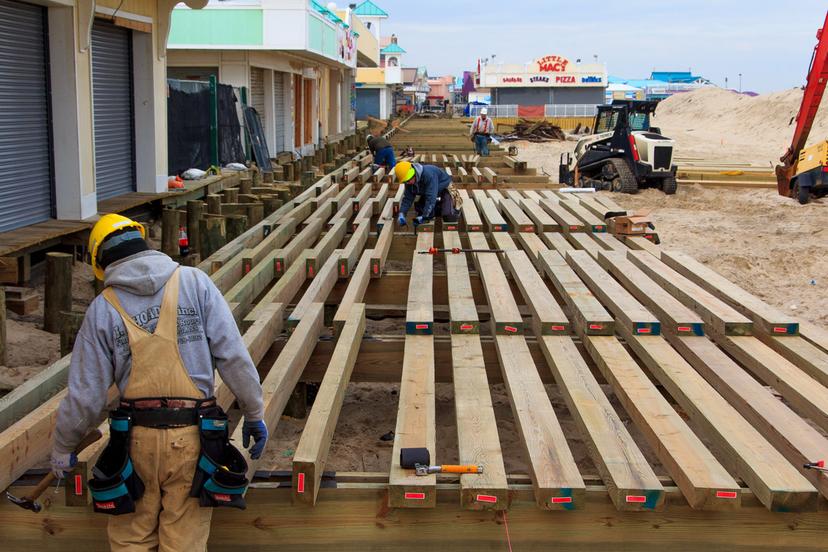Construction

Industry Outlook
Construction accounted for 6.36 percent of the U.S. annual gross national product in 2017. Physical facilities built by the construction industry include homes, stores and buildings, mills and factories, highways and streets, bridges, railroads, airports, wharves and docks, pipelines, tunnels, dams, power plants, irrigation projects, public works, and defense installations.
Whether it is the life savings of one family buying a home or the investment of a corporation to finance the erection of a skyscraper, it all adds up to a substantial yearly increase in national investment. The nation's banks, insurance companies, pension plans, and other financial institutions have a big stake in construction, for they finance most of it. Following the worldwide recession that began in 2009, most countries' economies, including the United States', struggled to return to pre-recession levels. The construction industry was directly affected, as both consumers and businesses choose not to spend capital during recession years. However, conditions had improved by the end of the decade. Citing data from the U.S. Department of Housing and Urban Development and the Commerce Department, in February 2019 the National Association of Homebuilders reported that single-family housing starts reached 872,800 in 2018. This not only was an increase of 2.8 percent over the previous year, but the highest level since the recession. Multifamily housing starts also were up in 2018, climbing 5.5 percent to 373,700.
In September 2019, the Department of Labor (DOL) issued its employment projections for 2018 to 2028. Construction ranked third among the fastest-growing industries (behind private education services and health care and social assistance). Construction-related employment was expected to increase 1.1 percent, resulting in the addition of 807,500 jobs by 2028. Two categories of jobs that will grow much faster than average, according to the DOL, are that of skilled and unskilled laborers. During the late 2010s, a steady supply of helpers and laborers was needed to support the construction of homes, offices, factories, schools, and power plants. Laborers who can perform a wide range of tasks will have more job opportunities.
Another factor driving the demand for workers is the need for the country to make major repairs to its infrastructure-highways, tunnels, bridges, dams, schools, power plants, water and sewer systems, subways, and airports-which will generate the need for all kinds of people employed in highway and heavy construction work. In addition to the increased numbers of projects, the construction projects themselves will grow in both size and complexity. New laws setting higher standards for building and construction materials, worker safety, energy efficiency, and pollution control will need to be addressed by skilled professionals with expertise in construction science, engineering, and management.
In 2019, the industry was benefiting from solid demand and low interest rates. However, it also faced a number of significant challenges. These included a shortage of construction workers, excessive regulatory burdens, not enough empty building lots, and decreasing affordability.
Employment growth is expected in highway, bridge, and street construction, as well as in repairs to prevent further deterioration of highways and bridges. Employment of construction managers, who oversee projects and ensure that laws are upheld, is expected to grow faster than the average through 2028. Managers with a bachelor's degree in construction science and work experience with a construction management services firm should have plenty of job opportunities.
Employment of drywall and ceiling tile installers is expected to grow slower than the average through 2028, at 2 percent, according to the DOL. The number of electricians is expected to grow by 10 percent, faster than the average, in the coming years. Painters working in construction also are expected to experience 10 percent employment growth through 2028.
All these factors point to an overall positive market for workers in the construction services. Although further technological improvements in construction methods and equipment are expected to raise the productivity of workers, the volume of activity will require substantial numbers of craftworkers in the various building trades, mostly as replacements for those who retired or left the industry during the recession. However, the construction industry is very sensitive to fluctuations in the national economy.
The construction industry, relying as it does on the labor of workers in close contact with each other, was greatly impaired by the 2020 coronavirus pandemic. As of April 2020, more than 40 percent of construction firms in the U.S. had laid off workers due to COVID-19, and global construction growth was revised from 3.1 percent down to 0.5 percent. The COVID-19 pandemic disrupted not only construction activities but the many business and services that support them by limiting access of architects and inspectors to construction sites, creating shortages in building supplies, and delaying approvals and permits. However, construction was also one of the first industries to return to work during the pandemic because so much of its work takes place outdoors. This occurred with limitations on the number of workers on a site at one time in an effort to avoid transmission of coronavirus.
As of late 2020, the U.S. construction industry was valued at $2 trillion, with more than 3.3 million businesses and nearly 9.4 million employees. One sector of the construction industry that experienced stability and growth throughout the pandemic is nonresidential construction, which in fact added 29,000 jobs in December 2020 alone. According to a Contractor Magazine article, "One of the brightest aspects of the employment report is the growth in jobs in heavy/civil engineering and among nonresidential specialty trade contractors." The growth in nonresidential specialty trade could be attributed to building owners taking advantage of empty office buildings (due to lockdowns and remote work) by modernizing structures. This is keeping construction firms, as well as smaller contractors, busier than normal. IBISWorld predicts that revenue growth for the construction industry will grow at a faster rate from 2020 through 2025, than the previous five-year time frame. In addition to the rapid growth anticipated in nonresidential construction, overall expansion in the industry will be driven by commercial and infrastructure construction.
